The invention of light-emitting diodes, as well as the technology for the production of lamps based on them, marked a new era in the field of lighting devices. Long-lasting, durable, bright and versatile - artificial light sources on diodes have already won their "place in the sun", and therefore the editors of the site "bestx.htgetrid.com/en/" have prepared for you an overview of the best LED lamps for 2020.
Content
Light sources - what are
There are the following types of artificial lighting - incandescent, fluorescent, halogen, LED.
Incandescent lamp (LN)

A classic and familiar to every person, a source of light, which was invented by the American Thomas Edison more than a hundred years ago. It is a transparent heat-resistant glass flask with electrodes and a heating body inside. The air from the flask was partially removed and replaced with an inert gas. The flask is connected to the base body, which has a thread for screwing into the cartridge. At the bottom of the base there is a contact with an electrode attached to it. Depending on the functional features, the design of a standard lamp can be modified or supplemented with related elements.
Such products are used both in residential and non-residential premises. They emit a pleasant light of warm colors, which does not irritate the eyes, even after a long stay in the room. Budgetary, and therefore in demand, however, they spend a lot of electricity and get very hot during the operation. The service life is 1,000 hours and largely depends on the conditions in which the device is used. LNs are sensitive to voltage surges, and therefore have to be replaced regularly due to combustion.
Luminescent

There are two types - low and high pressure. The former are used in residential premises, the latter are intended for street lighting. The service life of the device is 5 years, but on condition that it is turned on no more than five times a day.
Originally, a compact fluorescent lamp (CFL), which is also known as an energy-saving lamp, was a long cylindrical tube sealed on both sides, inside which mercury vapor is located. At this stage, manufacturers have improved the design and produce luminaires of various shapes and sizes. The cylindrical design remains the classic solution for this type of lighting device, but the U-shape is also popular.
Luminescent sources consume five times less electricity than LN, therefore they are often installed to illuminate large rooms, for example, classrooms, warehouses, industrial premises, etc.
Due to the fact that the bulb of the device during operation heats up no higher than 500C, CFL can be installed in places where fire safety is especially important.
But there are also negative aspects - low unit power, a decrease in the saturation of the luminous flux by the end of the service life, sensitivity to ambient temperature, specific sound and pulsation of light during operation, which can negatively affect the vision of the people present. Also, with a voltage drop of more than 10%, the fluorescent lamp simply will not light up.
Complicates the operation and disposal of such devices. Due to the presence of mercury, it is impossible to simply throw a spent installation into the trash, since if the tightness of the flask is damaged, the toxic substance contained inside will enter the air, and this threatens both human health and the environment. It is necessary to find a special company specializing in this profile and hand over the lamp to them.
Halogen
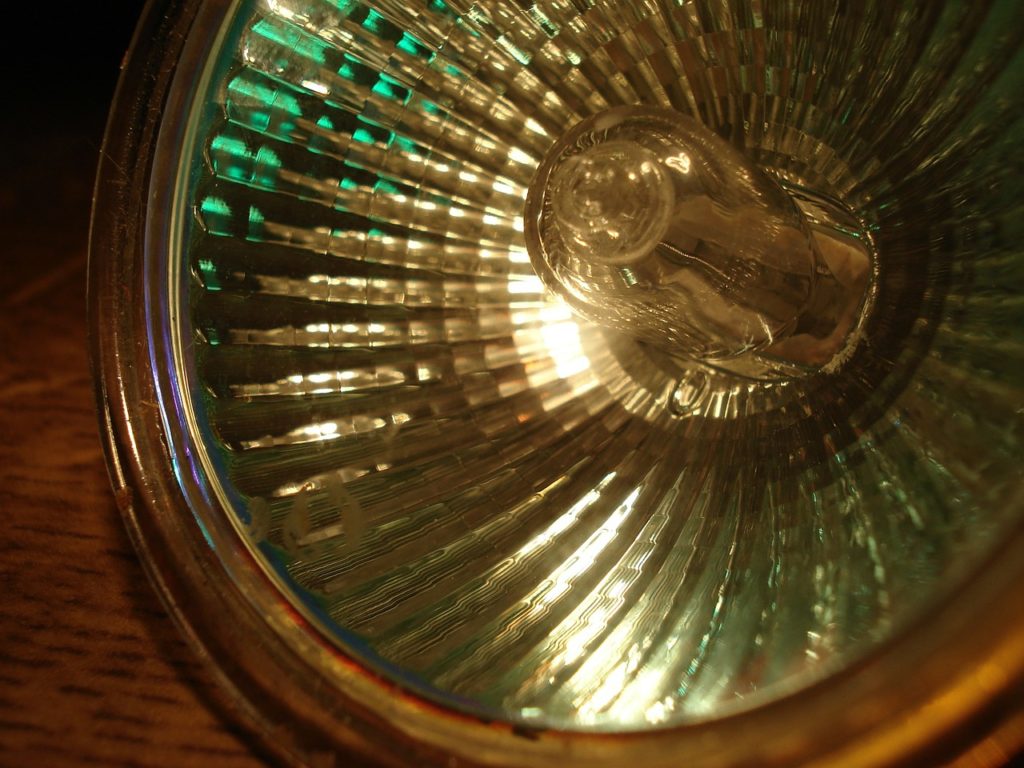
A more advanced version of the LN. The main difference is that the halogen bulb is filled with buffer gas vapors, due to which the operating temperature of the spiral element is several times higher and, accordingly, the duration of the use of the lighting product is significantly extended. According to manufacturers, halogen lamps have it between 2000 and 4000 hours. At the same time, the devices have the highest light transmission rates - almost 100%.
Halogens are available on the market in a wide range of models in various configurations. Such lamps can be partly built into furniture or mounted into the ceiling to create a point lighting system - they give a rich dense luminous flux despite their modest size.
The main disadvantage is vulnerability to damage and sensitivity to frequent switching on and off. It is these two points that are more conducive to the rapid failure of the luminaire.
LED

LED lamp or LED (Light emitting diode), as it is also called, works on the basis of LEDs, which are connected into one structure, equipped with a power supply. LED is an environmentally friendly light source. There are both full-fledged devices - LED lamps, and individual elements - replaceable LED bulbs.
Light fixtures
They can be roughly divided into the following categories:
- For street and architectural illumination - they are a sealed body isolated from moisture, made of materials with high heat-conducting properties;
- For industrial and office needs - they steadily transmit the light flux, and are also equipped with a case of increased strength, for example, made of polycarbonate;
- For household purposes, they have low performance, but must meet many requirements - for the quality of lighting, fire and electrical safety, and appearance.
A separate category should be allocated to the "smart lamp", the operating parameters of which (color, brightness, on and off times, etc.) are set and regulated using a smartphone.
Models with colored light-emitting diodes are used for decorative purposes, as well as for highlighting individual elements - signs in the subway, exhibits in museums, paintings at exhibitions, and so on.
Lamps
At the moment, products are being produced on diodes for all existing types of socles, they also have a power of up to 40 watts and are designed for installation in home lighting devices - wall and floor lamps.
A structurally replaceable diode light source consists of a hemispherical diffuser (bulb), chips with diodes (which can be up to a couple of dozen, depending on the power of the device), a printed circuit board, a radiator (which is necessary for heat dissipation), a driver (acting as a stabilizer voltage and smoothing ripple) and a base, the base of which is insulated with polymers for protection against current breakdown.
LED light sources consume little electricity, but at the same time create a bright and rich luminous flux. They have a service life of 30-50 thousand.hours, since their working elements rarely burn out.
With a huge number of advantages, the main disadvantage of LED devices is their high price, which is nevertheless gradually decreasing. In addition, the amount spent will pay off due to the reduction in electricity bills.
Next, we will consider the main selection criteria that will help you understand how to choose a good LED lamp.
Which LED lamp is better to buy
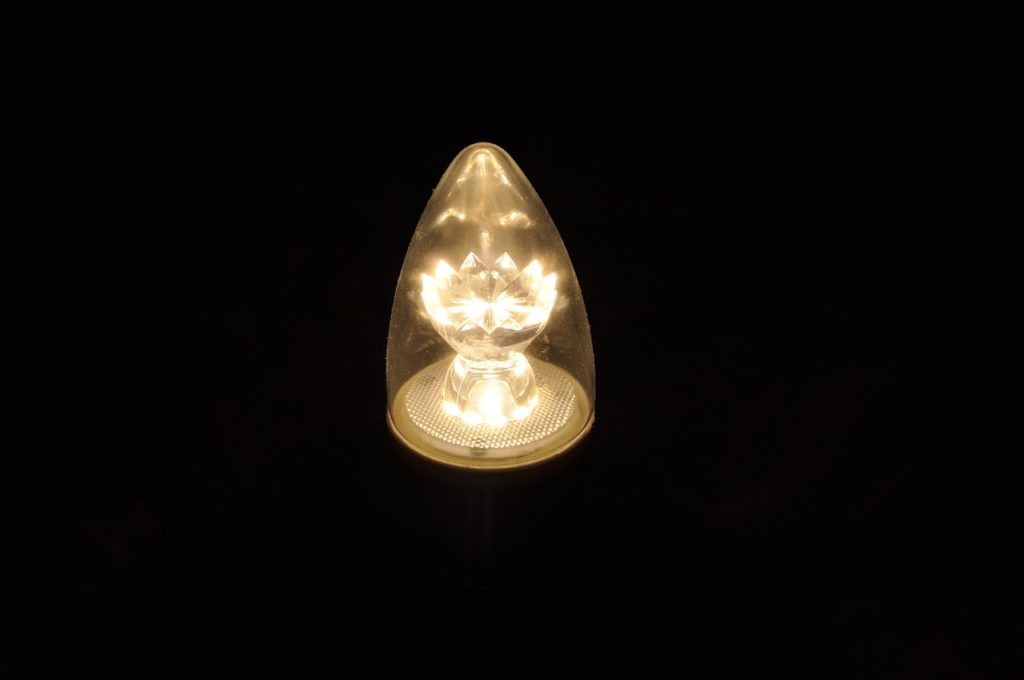
When buying, you should pay attention to parameters such as body material, base type, color temperature, luminous flux, voltage range and bulb shape.
Material
For the production of directional light flux diffusers, such sufficiently strong materials as transparent and opaque plastic, as well as frosted polycarbonate are most often used. For this reason, LED bulbs are much less fragile than incandescent and fluorescent bulbs, and can even withstand a drop from a low height without damage.
The board, as a rule, is made of an aluminum alloy, which guarantees that the temperature regime is optimal for operation. Also, radiators are made from aluminum and its alloys (anodized).
Plinth
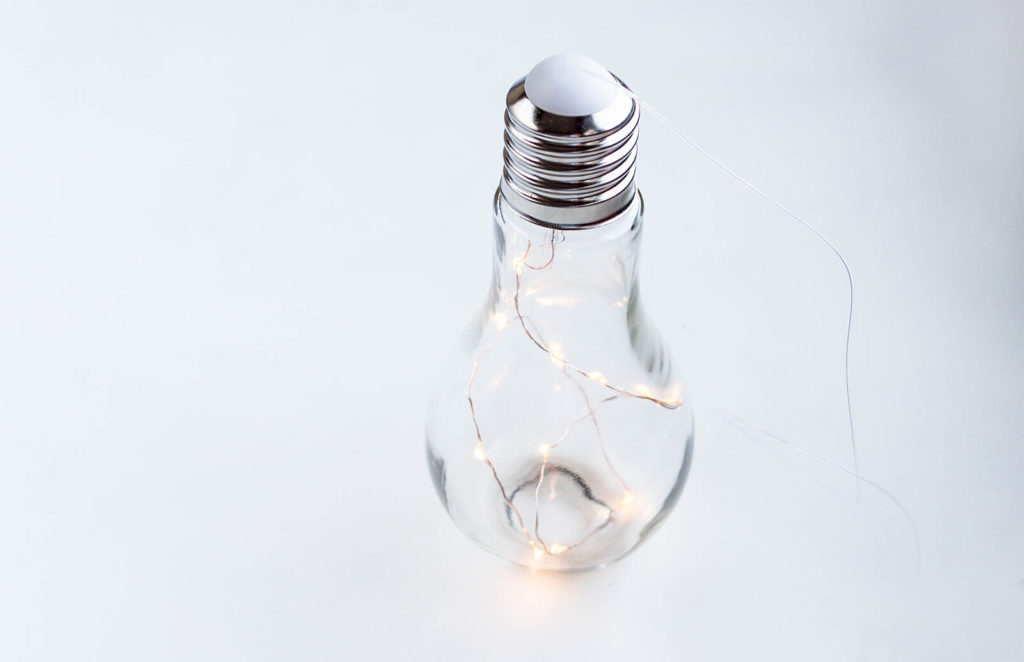
It is usually made of nickel-plated brass to prevent corrosion and ensure a firm contact with the luminaire holder.
There is more than one type of base and each of them has its own designation. It is composed according to a certain scheme - XXYYz, where XX is the type and subtype of the base, YY is a number indicating the diameter of the connecting part or the distance between the pins (pin base), z is the number of contact plates, pins or flexible connections.
Base types
The following base / plinth types are possible in LED devices:
- E-27 is the most common type of base for installation in lamps for household and office use. Numeral 27 indicates the diameter of the threaded portion in millimeters. Such a metal element is most often combined with a bulb in the form of a ball or hemisphere;
- E-14 is a slightly less common type than the first. It is found in less powerful items that are intended for table and wall sconces - "candle", "twisted candle", "candle in the wind";
- The G-53 / GX-53 is a rare type and is most often used to create a ceiling light module where flat top round bulbs are built in. G53 has flat contacts, GX53 has pins;
- B-22 - pin base with a diameter of 22 mm. Connection with bayonet-type socket, the feature of which is the quick connection of the metal part to the socket by axial displacement by turning the lamp in the luminaire. Most often this type is used in vibration conditions - cars, trains, sea transport;
- GU-10 is a pin type of fastening, where the number 10 means the distance between the pins, and with a large number of them, the diameter of the circle on which they are located. Most often, these products are used for ceiling and spot lighting;
- GU-5.3 - pin fastening system. As a rule, such devices equipped with this type of base have a small size and low power, they perform a decorative function for light accent lighting of objects;
- G-4, GU-4 and G-9 are equipped with pins, the distance between which is indicated in millimeters - 4 and 9 mm. They are used for design lighting, sometimes they come to replace halogens with a similar metal part. The main thing is to choose the appropriate voltage and type of current. The form is most often in the form of a "tablet".
Flask shape
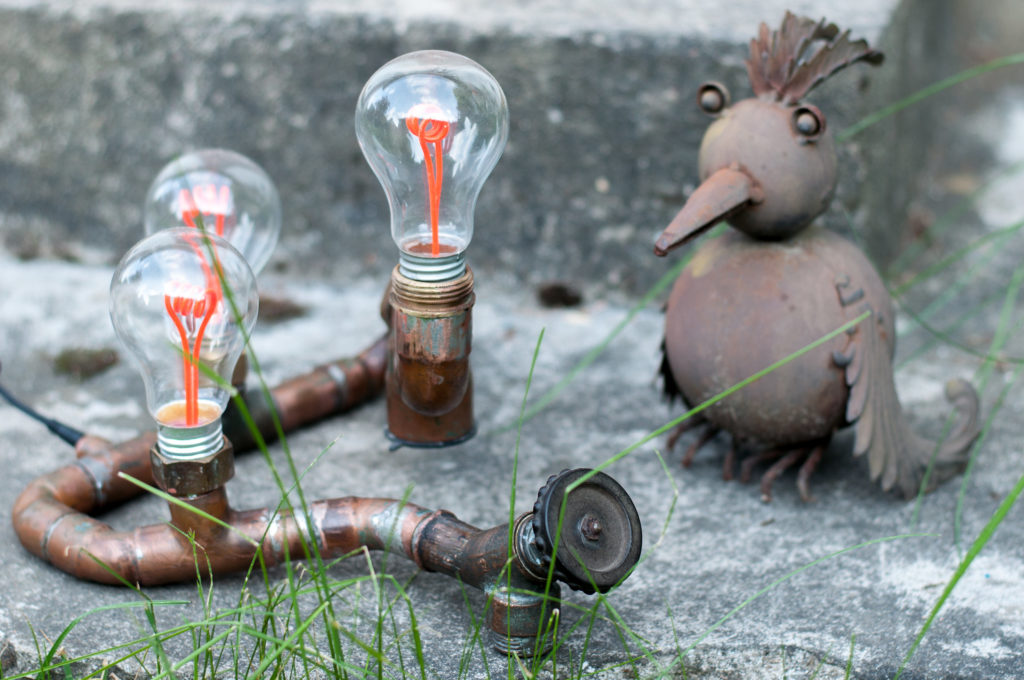
The bulb is an element that covers the light-emitting parts and performs two functions - it protects the "insides" from external influences, and also diffuses the light flux. It can be transparent, matte and mirror.
Replaceable lamps of various shapes are presented on the market, which largely determines the scope of the product. There is a general alphanumeric system for marking devices according to their shape, which is based on measurements of the device's diameter in millimeters.But everyday names are more common.
- "Pear"
The classic shape of the interchangeable light source. As a rule, it is designated by the letter "A" (arbitrary). According to their name, they are pear-shaped and are suitable for most lighting fixtures.
In the form of a pear, which has an external resemblance to the LN, filament lamps are produced. The peculiarity of such devices is that LED filaments are grouped and installed vertically on a glass substrate, thereby eliminating the need to install a voltage converter. The design avoids current limitation and rectification.
- "Candle"
Its execution resembles the light of a burning candle. It is marked with the letter "C" (candle). Fits in classic design wall and ceiling luminaires.
- "Candle in the Wind"
Such products imitate the flame of a candle shuddering from the wind with their design. They are designated as "CA" (candle angular) and have low performance. According to buyers, the best lamps of this shape are products with a warm glow.
- "Twisted candle"
Unlike the "candle in the wind", which has a narrowed curved tip, the "twisted candle" looks like an ice cream cone. Marked with the letters "CW" (candle twisted). Sometimes it can be marked with the letter "B". Suitable for luminaires with upward-facing holder. Candle-shaped devices are mainly for decorative purposes.
- "Ball"
It has a round or drop-shaped bulb and looks like pear-shaped products. However, it has a significant advantage - more efficient light distribution. Accompanied by a G (globe) mark.
- "Tablet"
Round and flat design, which is marked with a combination of letters "GX". It is characterized by a wide choice of diameters and is most often used as recessed elements to create a complete lighting system.
- "Ellipsoid"
It is designated by the letter "E" (ellipsoidal).
- "Reflector"
It has a distinctive mushroom-like appearance and is marked "R" (reflector). Due to the presence of a special reflector, it is capable of generating a dense light flux and, as a rule, is used in cases where spot lighting is needed.
- "Soffit"
It has some resemblance to a reflector, but differs in a flatter bulb at the top. Equipped with a pin metal part and is used for spot lighting. The packaging must be marked "MR".
- "A tube"
According to its name, it has a tubular shape and is marked as "T" (tubular). It is used as an artificial light source in commercial and office buildings.
- "Capsule"
Miniature bulbs that are designated by a combination of the letters "JC" and "JCD". Used as a replacement for halogen. They differ in the pin base - G4 and G9. They are mainly used for spot lighting, but can also be installed in chandeliers and sconces.
- "Corn"
The name comes from the shape resembling an ear of corn and the diodes arranged in rows like grains. Such a lamp has several boards and is assembled in the form of a prism with several faces. A pair of low-power diodes is installed on each of the boards, and from above the structure is covered with a bulb with holes for natural cooling. Due to its design, “Kukuruza” provides a more distributed light flux, and therefore does not need additional diffusers.
- "Cylindrical"
It has a screw base and is characterized by high power. Luminaires designed for industrial and street lighting are equipped with cylindrical products.
- "Spiral"
Equipped with a standard E-27 base, thanks to which such a lamp is successfully completed with general-purpose luminaires. They have a spiral shape of a bulb that diffuses the light flux. The popularity of these models is due to their versatility - they can be installed both in small tabletop devices and used for overhead lighting.
Light flow
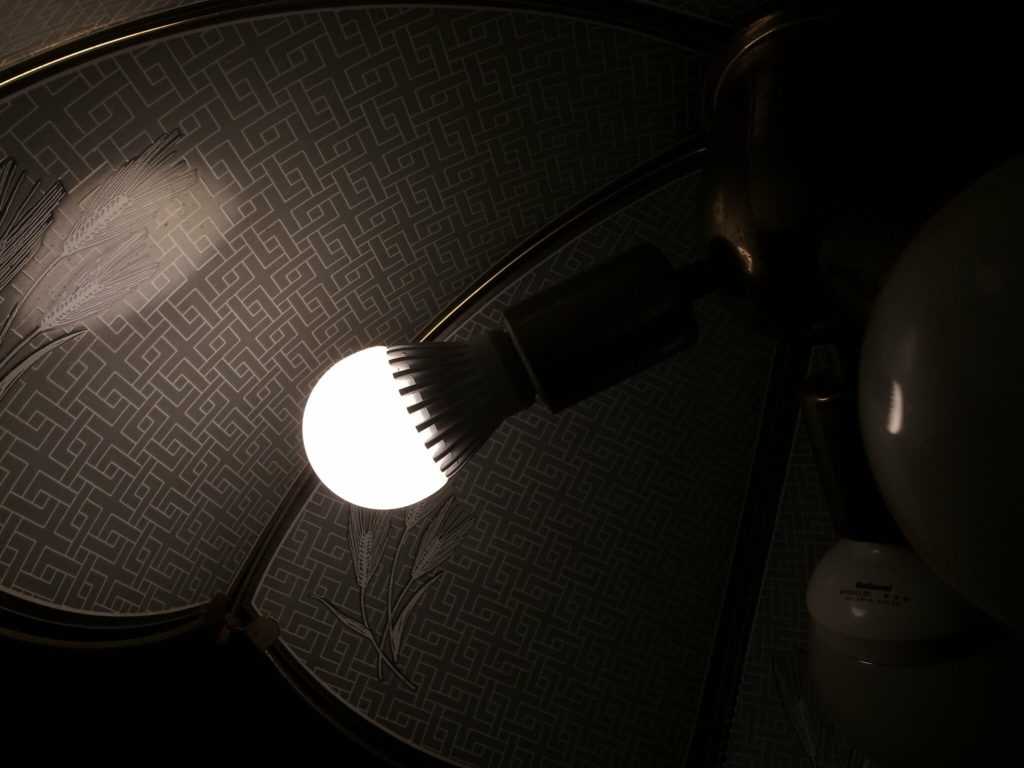
The luminous flux refers to the degree of brightness with which the light bulb is capable of shining.In LED products, this parameter is measured in lumens, denoted as lm or lm and is measured in units per m2... What brightness to give preference to a lamp depends on personal wishes, as well as on the purpose of the room. However, it is worth paying attention to the norms indicated in SNiP 23-05-95 "Natural and artificial lighting":
- For bedroom / kitchen - 150 lm / m2;
- For a children's room - 200 lm / m2;
- For bathroom / toilet - 50 lm / m2;
- For a general office - 300 lm / m2;
- For drawing works - 500 lm / m2.
Dimmer
A mechanism, the functionality of which allows you to control the light and adjust the level of illumination of the room.
Products in which it is possible to arbitrarily change the intensity of a particular light bulb using a dimmer are marked "dimmable" on the packaging. The robust dimmable luminaire is equipped with a pulse-width modulated driver that adjusts its brightness from 5 to 100%.
There are several types of dimmers. High-quality devices are expensive, but such devices are easier to install, since there is no need to understand the polarity of the connection. Expensive universal dimmers have several operating modes: "100%" - full power, "Good night" and "Good morning" - decrease in intensity within 30 minutes until complete shutdown, "Sleep" - 30% brightness of lighting for half an hour with subsequent shutdown.
Inexpensive dimmers from China or with Ali Express are much simpler and lose to the first in functionality, and therefore are cheaper. However, in contrast to affordability, they are unreliable, since they do not have a fuse and when the load is exceeded, such models begin to melt.
Power
One of the main advantages of LED devices is that they consume 6-8 times less electricity than LED devices. To facilitate the power selection process, there is an average diagram representing the ratio of energy consumption of LED and conventional luminaires:
| lm / m2 | LED / W | Incandescent / W | Fluorescent / W |
|---|---|---|---|
| 250 | 3 | 25 | 9 |
| 400 | 5 | 40 | 13 |
| 650-700 | 8 | 60 | 17 |
| 900 | 11 | 75 | 20 |
| 1200-1300 | 14 | 100 | 30 |
| 1800-2100 | 22 | 150 | 50 |
However, you should pay attention to the fact that the power declared on the package does not always correspond to the actual one - in some cases, the LED may shine slightly weaker than expected. In addition, you should be prepared for the fact that over time the brightness of the LEDs may decrease - it all depends on the quality of performance.
Voltage range
Unlike LN, the functionality of which depends on voltage stability and its maximum proximity to 220 W, LED products for transmitting a stable light flux are sufficiently lower values, moreover, they are not susceptible to network transmissions.
Scattering angle

The functionality of LEDs is such that they are able to shine exclusively directly, and the degree of distribution of the light flux depends not so much on the number of lighting elements as on the way they are located.
Ripple
In low-quality LEDs, the luminous flux can be unstable and pulsate imperceptibly, which can lead to poor health and negatively affect both the nervous system and visual acuity.
Colour temperature
The color temperature, which is measured in degrees Kelvin (K), refers to the color of the emitted light flux. And the lower this indicator, the warmer the light will be, and as the value increases, the light will tend to cool blue shades.
The color temperature of the device must be indicated by the manufacturer on the packaging or marked on the body of the product:
- 2700 K - super warm;
- 2800 K - warm yellow;
- 3000 K - warm white;
- 4000 K - neutral white;
- 6000 K - cold white.
What temperature to choose for lighting is a matter of taste, but there are some universal recommendations.
Tips for choosing a color temperature
- Warm and ultra-warm color temperature devices that produce yellow dim light are conducive to calming and relaxation.Such lamps are appropriate in bedrooms and other resting places, but in rooms that provide for active physical or intense mental activity (gym, study, office), such a light will create a depressing impression.
- Cold-toned luminaires have the opposite effect - they create bright lighting that has a stimulating effect. These devices are suitable for installation in swimming pools, dance classes, utility and utility rooms, etc. However, you should be careful - if you stay in a room with a bright cold light for a long time, headaches, irritation and a feeling of overwork may occur.
- White Light - Daytime White and Warm White are versatile and will work just about anywhere. The white light bulb is suitable for home, apartment, office, warehouse, shop, etc. And neutral white blends well with natural light coming through the window and complements it, which is especially important when there is a lack of sunlight.
Color rendering index
The color rendering index refers to how correctly the color spectrum of artificially illuminated objects is displayed in comparison with a natural source. The need to introduce this parameter is due to the fact that two different types of lamps with the same color temperature can transmit colors in different ways. The color rendering index is indicated by the code "Ra" or "CRI", which stands for color rendering index.
The color rendering index is determined by fixing the color shift using eight or fourteen reference colors - the tested luminaire is directed to the reference colors and the numerical value of the deviation of the visible color from the standards is calculated. The smaller the deviation, the better the color rendering performance. Thus, a color rendering index of 100 Ra means that the luminaire reproduces the colors of the illuminated object optimally and naturally. The lower the value, the worse the colors are displayed.
Selection errors
- Trust in an unverified manufacturer. One-day firms, which today have one name, and tomorrow another, do not particularly care about their own reputation, and therefore quite calmly sell low-quality products, luring buyers with a low price. It should be remembered that in order to reduce the cost, the manufacturer saves, first of all, on consumables, which will invariably affect the operational properties of the device. Some manufacturers, seeking to reduce the level of heat generation and increase light output, but at the same time save part or all on parts, ignore the need to smooth out ripple current. As a result, such products emit flicker invisible to the naked eye, which, although not noticeable, is dangerous for the eyes. And due to the lack of heat dissipating elements, overheating and, accordingly, damage to the diodes is possible, especially in closed lampshades and shades.
- Product warranty. In LED, the quality of the diodes is important, on which functionality, durability and operating conditions depend. And as soon as one chip breaks down, the product will immediately stop working. There are few manufacturers of high-quality LED lamps, and they all give a guarantee for their products.
- Product information. The packaging must contain a description for the product. The manufacturer must indicate the following characteristics - light shade (color temperature), power, energy efficiency class, service life, performance.
Advantages and disadvantages
Advantages of LED devices:
- Have a longer service life compared to fluorescent or incandescent lamps;
- It is used for household, office, street and industrial lighting;
- Save energy efficiently;
- Easy to install by hand;
- Strong and durable;
- Environmentally friendly, made from non-toxic materials, do not have or emit hazardous substances;
- They do not need complicated disposal, unlike fluorescent lamps;
- Provide rich bright light even at low mains voltage;
- They do not create harmful radiation and do not harm furniture, as well as decor items and interior elements;
- The variety of sizes and shapes of modern LEDs makes it possible to choose the necessary lighting product for any chandelier or sconce. The table lamp can also be equipped with an LED, even if the device is classified as a rarity.
Disadvantages:
- The high cost of the product;
- Most LED products shine in one direction.
Main technical characteristics
| room | Specifications | Recommendations |
|---|---|---|
| 1 | Flask | The cylindrical shape, as well as "ball", "corn" and "pear" are multi-purpose, suitable for overhead lighting. For installation in lamps and sconces, it is better to choose "candle", "twisted candle", "candle in the wind". Soffit and tablet are well suited for creating spot lighting. |
| 2 | Power | 3 to 5 W - low-power products, 6 to 11 W - medium power devices, 12 to 22 W - high power LEDs. For example, a 12-14 W LED luminaire will create the same illumination as a conventional 100-watt incandescent light bulb. |
| 3 | Base type | The most common caps are E-27 and E-14. |
| 4 | Colour temperature | 3000K (warm white) and 4000K (neutral white) are the most versatile values. |
| 5 | Voltage | When buying, it is worth choosing the product with the largest voltage range. |
| 6 | Color rendering | According to the standards, it is best to use products with an index of at least 80 CRI / Ra in residential premises. |
| 7 | Scattering angle | Depending on the design features, the scattering angle can vary from 30 to 360 degrees. |
| 8 | Ripple | According to the recommendations of experts, you should choose devices with a pulsation interval of no more than 15%. |
| 9 | Maintainability | In some cases, LEDs stop working due to poor contact. The problem can be corrected, however, you should only take on the repair of the device with your own hands after reading the rules for working with electrical appliances, since the electrical circuits of LED lamps are associated with the mains phase and it is important to be extremely careful. |
| 10 | How much is | In terms of price, diode light sources differ depending on the characteristics and manufacturer. The average price for a standard LED product is 180 rubles, a "smart lamp" will cost 1250 rubles. |
Rating of quality lamps for 2020
Xiaomi Yeelight LED Bulb Color Silver (YLDP02YL)
Manufacturer: China
Flask: cylindrical
Base type: E-27
Power: 9W
Voltage: 220-240W
Luminous flux: 600 lm
Color temperature: 1700 - 6500 K
Price - 1,500 rubles.
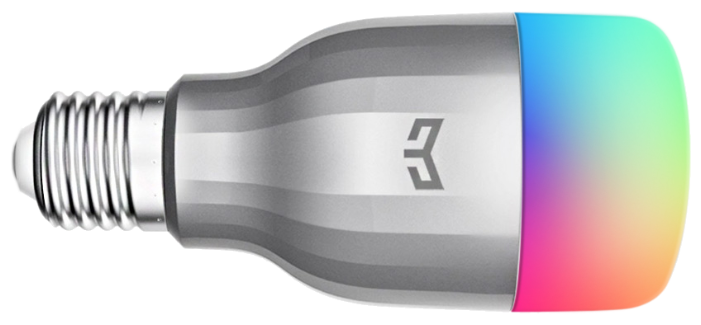
Energy-saving multifunctional LED "smart lamp" with frosted diffuser and remote control of operating parameters. The LED size is 120mm in length and 55mm in diameter. The service life declared by the manufacturer is 25,000 hours. Scattering angle - 3600.
Advantages:
- wireless control;
- Wi-Fi connection;
- suitable for work in the "smart home" system;
- wide angle of dispersion;
- you can set a schedule for switching on and off;
- convenient application;
- stepless color control;
- can be used as an alarm clock;
- there are several thematic modes, including color music mode;
- good feedback.
Disadvantages:
- there is no possibility of connecting a dimmer;
- there is a hum when turned on at maximum brightness.
Manufacturer: Russia
Flask: tablet
Base type: GX-53
Power: 10W
Voltage: 220-240W
Luminous flux: 800 lm
Color temperature: 4000K
Price - 200 rubles.
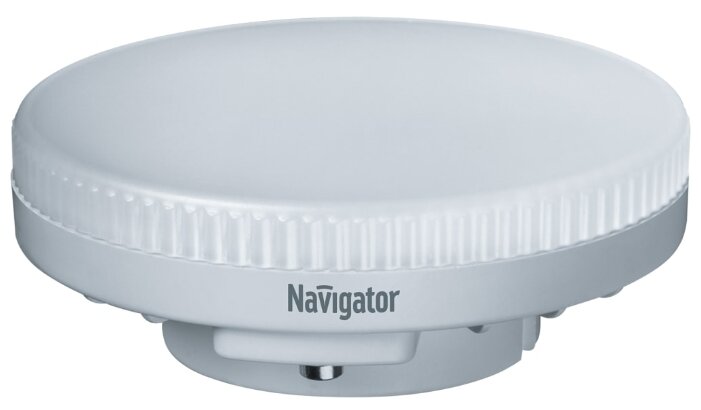
Daylight white LED product with matt diffuser. Color rendering index is 89 Ra. The power is equivalent to a 75 watt incandescent lamp. The device is 28 mm long and 74 mm in diameter. The service life is 40,000 hours.Designed for alternating current.
Advantages:
- powerful;
- turns on instantly;
- high level of color rendering;
- there is no pulsating effect;
- the flask does not heat up;
- works stably at temperature drops;
- long service life;
- low cost.
Disadvantages:
- without the possibility of connecting a dimmer.
Philips Led Xiaomi Rui Chi Bulb
Manufacturer: Netherlands
Flask: candle
Base type: Е-14 / standard size С-42
Power: 3.5W
Voltage: 220-240W
Luminous flux: 250 lm
Color temperature: 5700K
Price - 1000 rubles.
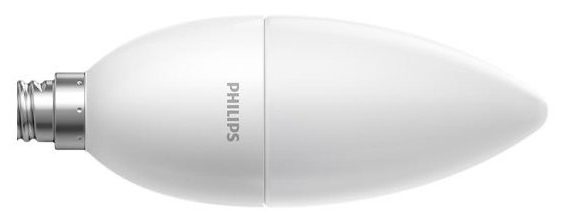
Frosted filament lamp classified as smart home and emitting cool white light. It has a wireless control function, as well as several modes - for sleeping, for reading and watching movies, for daylight. There is such a parameter as creating your own mode. Color rendering index is 80 Ra. The size is 127 mm long and 42 mm in diameter. Service life - 15000 hours.
Advantages:
- connects to Wi-Fi;
- it is possible to adjust the brightness of the light using a proprietary application on a smartphone;
- minimalistic design;
- meets all the required technical specifications.
Disadvantages:
- a small number of declared working hours;
- high price.
Ecola G9RV10ELC
Manufacturer: China
Flask: corn
Base type: G-9 / size corn
Power: 10W
Voltage: 220W
Color temperature: 4,200 K
Price - 200 rubles.

LED micro lamp with transparent diffuser. Creates daylight white lighting suitable for both residential and office buildings. The color temperature indicator indicates that the luminaire produces light in neutral shades that are not harmful to health. In length it has a size equal to 65 mm, diameter is 19 mm. Duration of work - 30,000 hours.
Advantages:
- high performance;
- has a dust and moisture protection (IP20);
- corn shape provides the widest possible lighting angle (3600);
- affordable price.
Disadvantages:
- without dimmer.
gauss 105102107-D
Manufacturer: Russia
Flask: ball
Base type: E-27 / standard size G-45
Power: 7W
Voltage: 150-265W
Luminous flux: 560 lm
Color temperature: 3000K
Price - 360 rubles.
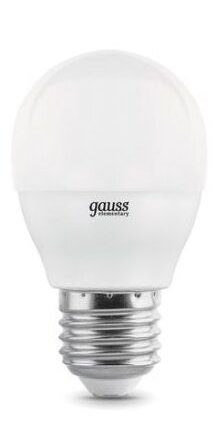
Energy saving device with matte bulb, equivalent in power to 60W incandescent light bulb. Calculated for an area of 3.5 m2... Illuminates the room in warm white colors. The color rendering index is as close to natural as possible - 90 Ra. Length 78 mm, diameter 45 mm. The service life declared by the manufacturer is 35,000 hours.
Advantages:
- wide voltage range;
- light of warm shades;
- dust and moisture protection (IP20);
- with the ability to connect a dimmer;
- ergonomics;
- laconic design;
- high color rendering index;
- affordable cost.
Disadvantages:
- small lighting area.
ERA B0017746
Manufacturer: Russia
Flask: U-shaped
Base type: GU-5.3 / frame size MR-16
Power: 4W
Voltage: 170-265W
Luminous flux: 320 lm
Color temperature: 2700K
Price - 70 rubles.

Product with LEDs and frosted light beam diffuser. Creates warm white lighting. Calculated for an area of 2 m2... The transmission index is equal to the recommended level - 80 Ra. In accordance with the declared power, the luminaire is equivalent to a 35 W LN. The service life of the product is 30,000 hours, which equals 3.5 years. Length - 50 mm, diameter - 50 mm.
Advantages:
- large voltage spread;
- has dust and moisture protection (IP-20);
- super warm shade;
- versatile design.
Disadvantages:
- without connecting a dimmer;
- small angle of dispersion.
VOLPE UL-00010808
Manufacturer: China
Flask: cylindrical
Base type: E-27 / standard size M80
Power: 25W
Voltage: 175-250W
Luminous flux: 2200 lm
Color temperature: 3000K
Price - 190 rubles.
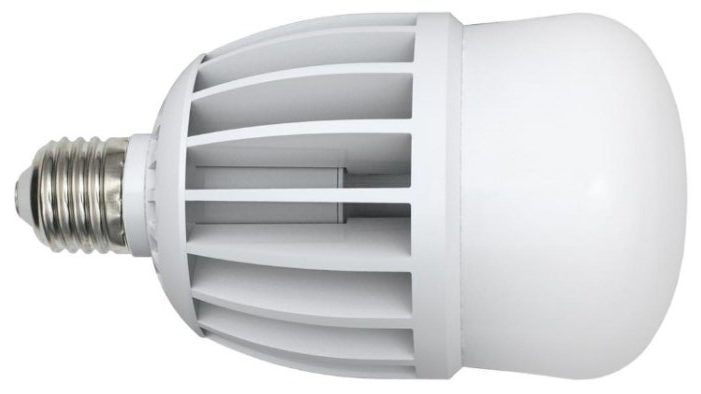
Matt luminaire for warm white light. Equivalent to 220W LP. The gear index is 80 Ra. Device weight - 330 g, length - 146 mm, diameter - 80 mm. The functionality is designed for 25,000 hours of operation.
Advantages:
- significant productivity;
- wide voltage range;
- high brightness;
- conveys colors naturally;
- warm shades that do not cause discomfort;
- equipped with dust and moisture protection;
- affordable price.
Disadvantages:
- without connecting a dimmer;
- custom design.
ASD LED-A60-STD
Manufacturer: China
Flask: pear
Base type: E-27 / standard size A-60
Power: 15W
Voltage: 210-240 rubles.
Luminous flux: 1350 lm
Color temperature: 4000K
Price - 90 rubles.

LED pear shaped lamp with frosted diffuser. Increased color rendering - 89 Ra. The device weighs 55 g, the length is 110 mm, and the diameter is 60 mm. The service life is 30,000 hours, which is equivalent to 1250 days.
Advantages:
- high brightness indicators;
- protection against dust and moisture (IP 20);
- color reproduction close to natural;
- significant productivity;
- versatile design;
- wide angle of dispersion;
- acceptable price.
Disadvantages:
- without dimmer.
gauss LED Candle tailed
Manufacturer: Russia
Flask: candle in the wind
Base type: E-14 / standard size CA-35
Power: 6.5W
Voltage: 150-265W
Luminous flux: 520 lm
Color temperature: 2,700 K
Price - 150 rubles.

A decorative light source with a power equivalent to a 60 Watt LN. Emits low brightness warm white light and is designed for an area of 3.3 m2... The high color rendering index - 90 Ra indicates the most natural color rendering in the illuminated room.
Weight is 88 g, length is 125 mm, diameter is 35 mm. The service life of the product is 35,000 hours.
Advantages:
- voltage range present;
- protected from moisture and dust;
- conveys super warm tones;
- elegant appearance;
- affordable cost.
Disadvantages:
- no dimmer;
- small lighting area.
OSRAM LS CLA100
Manufacturer: Germany
Flask: pear
Base type: E-27 / standard size A-60
Power: 11.5W
Voltage: 220W
Luminous flux: 1060 lm
Color temperature: 2700K
Price - 150 rubles.
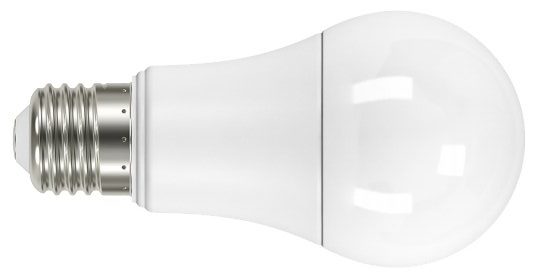
A matt product with a classic design that creates warm white lighting. Equivalent to 100 watt LN. The minimum recommended color rendering level is 80 Ra. Length - 120 mm, diameter 60 mm. The service life is 15,000 hours.
Advantages:
- significant productivity;
- stylish design;
- super warm shades;
- brightness;
- protection from moisture and dust.
Disadvantages:
- small voltage range;
- there is no possibility of connecting a dimmer.
Which company is better
The best manufacturers of quality LED light sources:
- Nichia is a Japanese firm specializing in the development of diodes and accessories. It is one of the oldest in its industry. Has a reputation for high-end products and is considered the leader in super-bright devices.
- Osram is a German brand founded over a hundred years ago. It is associated with another well-known company - Siemens, and owns almost fifty factories around the world.
- Cree is an American company that originally made chips that were used to make mobile phones and car dashboards. Today, a well-established company produces LEDs for various purposes with a full cycle.
- Philips is a renowned corporation with factories in 60 countries and is renowned for its investment in innovation. It has an annual turnover of millions of euros and a strong growth rate in production volumes.
In addition to the above, popular models of diode lighting devices are produced by Russian brands - "ERA", "Gauss", "Navigator", "Ecola", as well as Chinese companies - "ASD" and "VOLPE".
If you have experience in using LED lamps described in the rating, or a more interesting model, tell us about it in the comments.












